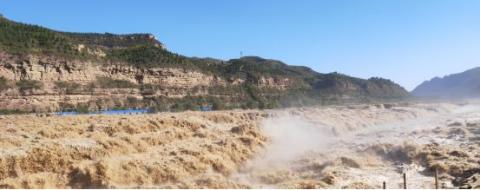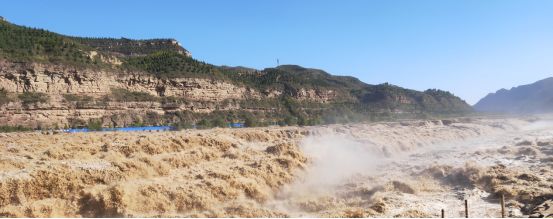

Hukou Waterfall in Yichuan County. In fact, Hukou Waterfall can also be seen in Shanxi, but when we went, it happened to be the flood season in Shanxi and Hukou was closed, so we must check the flood season of Hukou Waterfall before going to avoid missing the visit by going in the wrong direction.

Hukou Waterfall
Where the Yellow River enters the "Hukou", the turbulence flows down rapidly, and the water mist stirred up rises into the sky, steaming clouds reach the sky, like billowing smoke rising from the bottom of the water, and can be seen dozens of miles away.
Be sure to pay attention to safety when there are many people. The best viewing periods are in April, May and October. In December, you can only see the frozen scenery, which is also very spectacular.

Along with the waterfall, a series of peculiar sights appear, mainly including eight wonders, which are called: smoke under the water, boating on dry land, neon lights playing in the water, mountains flying into the sea, clear sky raining, dry weather thundering, ice peak hanging upside down, and ten-mile dragon trough .
The 8 wonders can only be seen in different seasons. No matter which season, I hope you can see a different Hukou Waterfall. Its surging momentum flows on the loess land year after year, day after day, raising the children on both sides of the Yellow River. Many classic myths have been spread. Dayu controlled the water and passed through the Dragon Gate. When the Dragon Gate opened, Hancheng came .

Han Cheng
"Huangmiao Lane, Chongyi Lane, and Lane 72 show the ancient style; the tower is the head, the bridge is the tail, and the one-stop street is deeply cultural; Longmen is in the north, Sima is in the south, and Little Beijing is in the middle." This nursery rhyme sings the Korean The city’s customs, culture and culture make Hancheng Old Town known as “Little Beijing”. Because during the Ming and Qing Dynasties, especially during the Qianlong period of the Qing Dynasty, there were too many officials in Hancheng in the capital, so the saying "Chao half Shaanxi, Shaanxi half Han" appeared. In view of the unique customs of Hancheng, Qianlong issued three decrees: 1. People in Hancheng can wear dragon robes and phoenix crowns when getting married; 2. Residential houses can be built imitating the courtyard houses of Beijing aristocrats; 3. After death, the system of Beijing aristocrats can be followed. Therefore, Hancheng has the reputation of "Little Beijing".
Once you enter the thousand-year-old Hancheng City, the streets, alleys, towers and temples are speechless. I will give you a map.

Let’s start with a restaurant in Hancheng Old Town
Sanshe Mansion
They are some of the old ruined courtyards in the ancient city.
The restored Sanshe blue bricks and gray tiles have an antique look
three courtyards
It has the saying "One life brings two, two brings three,
"Three things give rise to all things"
Laozi philosophy
At the same time, he also has the feeling of "you will gain only if you give up"
The scenery is beautiful and the food is delicious. You can taste the authentic food of Shaanxi slowly in this quiet courtyard.
During a night tour of Hancheng City, there are seventy-two lanes in the old city, which are criss-crossed like a chessboard and arranged like stars. I can’t show you all here. Let’s just take a look at the Chenghuang Temple and the alleys.

The stage of Chenghuang Temple faces west to east. It was originally composed of east and west terraces. The west terrace now exists, but the east terrace has been destroyed. It was founded in the 44th year of Wanli in the Ming Dynasty (1616) and has been renovated in every dynasty. It now maintains the architectural characteristics of the Ming Dynasty, and some structures have been changed to the French style of the Qing Dynasty. The stage is a platform-based building with a five-beam roof truss structure. The top of the cross-shaped hilltop with double eaves is covered with gray boards and tube tiles, and glazed peonies are placed on the ridge.
Because of the night, it is not allowed to take many photos of the temple. It took us 30 minutes to finish visiting the Chenghuang Temple and walk in the busy alleys. It was difficult to take photos with so many people waiting in the alleys.
During the Ming and Qing Dynasties, as many as 1,396 people passed the imperial examination in Hancheng. Among them, 119 are Jinshi; one is the top scholar, three are members, and 11 are Jieyuan. In the Ming Dynasty, the population of Hancheng was only 60,000, and in the Qing Dynasty, it was only more than 100,000. However, there were many officials in the capital, more than 130 people of fifth rank or above. Some scholars call Hancheng the "cradle of high officials", but Hancheng people say: "The local scholarly spirit is so mellow that all households can be sealed."

The final official position of this family was that of imperial guards. There were high plaques hanging on top of the family name. There were many plaques on the left wall. Looking at the plaques, I thought that the college entrance examination was nothing more than that. It was just the first step for the five sons to pass the college. It depends on you and me when you will enter the clouds. Who is a neighbor and who is a companion.

The ancient city of Hancheng is also called Jincheng. There is a golden pagoda on the city, which is a battleground for military strategists. The tower bell rang with the wind, overlooking the entire ancient city of Hancheng, with dim lights.

In such a casual and comfortable Hancheng, food is naturally indispensable. The most famous peppercorns can be used to make various delicacies, such as peppercorn sorbet, peppercorn yogurt, peppercorn leaves, etc. There are also a variety of different snacks at the most beautiful night market in Asia.
Delicious food is not only filling but also amazing.
It’s not just the food that’s amazing, but also the Dangjia Village, which was praised by the Royal Architectural Institute of England.
“Oriental architectural culture in China, Chinese residential architectural culture in Hancheng“
Ancient Korea Sima Qian alone wrote half of the history of China, and his literary tradition has a long history. Although Dangjia Village was built by the ancestors of the Dang family who moved here, it has become a well-known cultural town due to the influence of Hancheng's literary style for more than 600 years.
There are more than 120 courtyard houses and 11 ancestral halls preserved in the village, which is known as "the living fossil of the ancient traditional residential villages of Eastern humans".
There are "door pier stones" on both sides of the door, which are divided into square, drum, and animal shapes. The square and drum shapes are also carved with figures, animals, flowers, etc., and the shapes are vivid and lifelike.




































